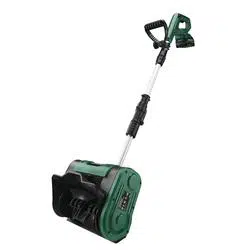Loading ...
Loading ...
Loading ...

Page 7
SAFETY INSTRUCTIONS
3. Always use a clean-out tool, not your
hands.
MAINTENANCE AND STORAGE
1. Check all bolts or fasteners at frequent
intervals for proper tightness to be sure the
equipment is in safe working condition.
2. Always refer to the operator’s manual for
important details if the snow shovel is to be
stored for an extended period.
3. Maintain or replace safety and instruction
labels as necessary.
4. Run the tool a few minutes after shoveling
snow to prevent freeze-up of the auger
assembly.
IMPORTANT SAFETY
INSTRUCTIONS
1. To reduce the risk of electric shock or
damage to the chargers and batteries, use
only with the MASTERFORCE
®
20V battery
packs and chargers listed.
Battery pack Charger
252-8029 (1.5Ah)
252-8031 (2.0Ah)
252-8030 (2.5Ah)
252-8003 (2.5Ah)
252-8034 (4.0Ah)
252-8013 (4.0Ah)
252-8035 (5.0Ah)
252-8005 (5.0Ah)
252-8007 (7.5Ah)
252-8025
252-8037
252-8026
252-8043
2. Store idle tool indoors. When not in use,
the cordless snow shovel should be stored
indoors in a dry, locked place.
DANGER:
People with electronic
devices, such as pacemakers, should
consult their physician(s) before using this
product. Operation of electrical equipment
in close proximity to a heart pacemaker
could cause interference or failure of the
pacemaker.
WARNING:
• Some dust created by power sanding,
sawing, grinding, drilling, and other
construction activities contains chemicals
known to the state of California to cause
cancer, birth defects, or other reproductive
harm. Some examples of these chemicals
are:
– Lead from lead-based paints
– Crystalline silica from bricks, cement, and
other masonry products
– Arsenic and chromium from chemically-
treated lumber
• Your risk from these exposures varies,
depending upon how often you do this type
of work. To reduce your exposure to these
chemicals:
– Work in a well-ventilated area.
– Work with approved safety equipment, such
as dust masks that are specially designed to
filter out microscopic particles.
– Avoid prolonged contact with dust from
power sanding, sawing, grinding, drilling,
and other construction activities. Wear
protective clothing and wash exposed areas
with soap and water. Allowing dust to get into
your mouth or eyes or to lie on the skin may
promote absorption of harmful chemicals.
SAVE THESE INSTRUCTIONS!
Loading ...
Loading ...
Loading ...
